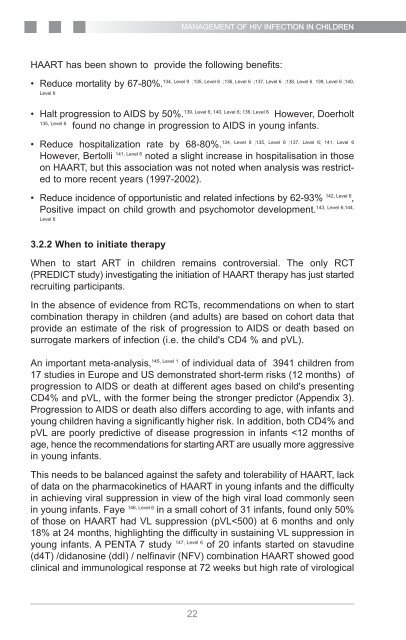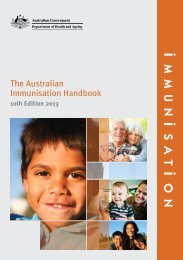3.30 MB - Academy of Medicine of Malaysia
3.30 MB - Academy of Medicine of Malaysia
3.30 MB - Academy of Medicine of Malaysia
Create successful ePaper yourself
Turn your PDF publications into a flip-book with our unique Google optimized e-Paper software.
HAART has been shown to provide the following benefits:<br />
134, Level 9 ;135, Level 6 ;136, Level 6 ;137, Level 6 ;138, Level 6 139, Level 6 ;140,<br />
• Reduce mortality by 67-80%.<br />
Level 6<br />
• Halt progression to AIDS by 50%. 139, Level 6; 140, Level 6; 136, Level 6 However, Doerholt<br />
135, Level 6 found no change in progression to AIDS in young infants.<br />
134, Level 6 ;135, Level 6 ;137, Level 6; 141, Level 6<br />
• Reduce hospitalization rate by 68-80%.<br />
However, Bertolli 141, Level 6 noted a slight increase in hospitalisation in those<br />
on HAART, but this association was not noted when analysis was restricted<br />
to more recent years (1997-2002).<br />
• Reduce incidence <strong>of</strong> opportunistic and related infections by 62-93% 142, Level 6 ,<br />
143, Level 6;144,<br />
Positive impact on child growth and psychomotor development.<br />
Level 6<br />
3.2.2 When to initiate therapy<br />
MANAGEMENT OF HIV INFECTION IN CHILDREN<br />
When to start ART in children remains controversial. The only RCT<br />
(PREDICT study) investigating the initiation <strong>of</strong> HAART therapy has just started<br />
recruiting participants.<br />
In the absence <strong>of</strong> evidence from RCTs, recommendations on when to start<br />
combination therapy in children (and adults) are based on cohort data that<br />
provide an estimate <strong>of</strong> the risk <strong>of</strong> progression to AIDS or death based on<br />
surrogate markers <strong>of</strong> infection (i.e. the child's CD4 % and pVL).<br />
An important meta-analysis, 145, Level 1 <strong>of</strong> individual data <strong>of</strong> 3941 children from<br />
17 studies in Europe and US demonstrated short-term risks (12 months) <strong>of</strong><br />
progression to AIDS or death at different ages based on child's presenting<br />
CD4% and pVL, with the former being the stronger predictor (Appendix 3).<br />
Progression to AIDS or death also differs according to age, with infants and<br />
young children having a significantly higher risk. In addition, both CD4% and<br />
pVL are poorly predictive <strong>of</strong> disease progression in infants

















